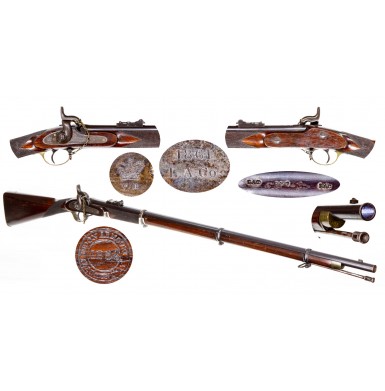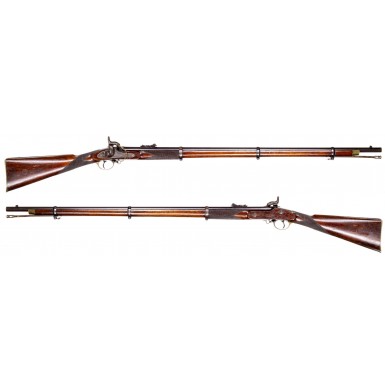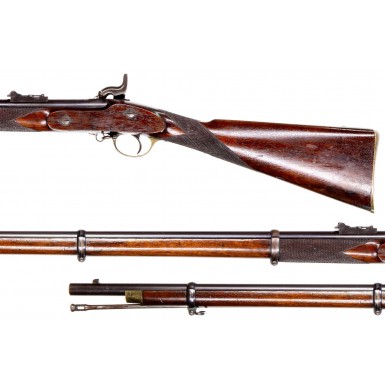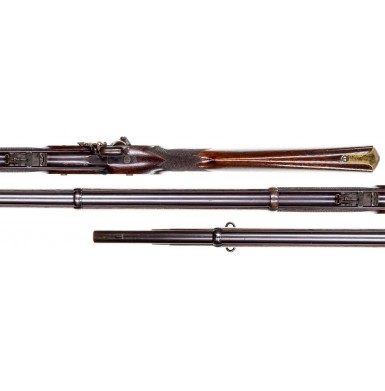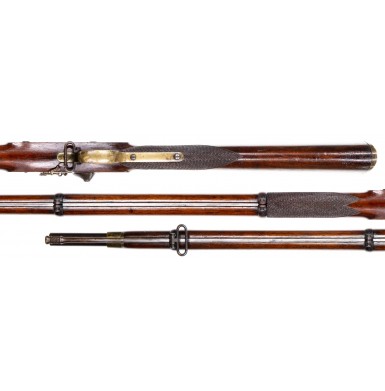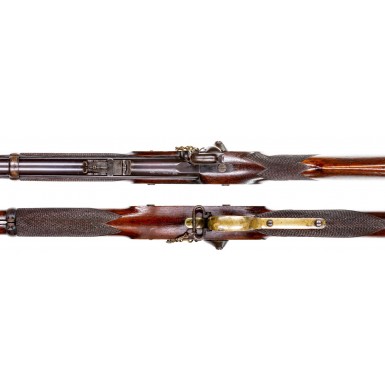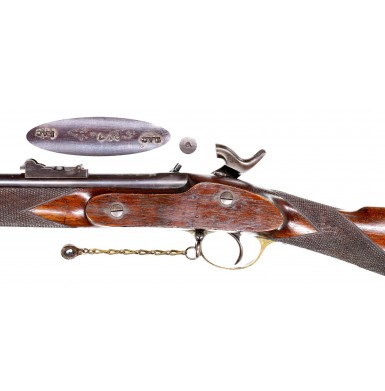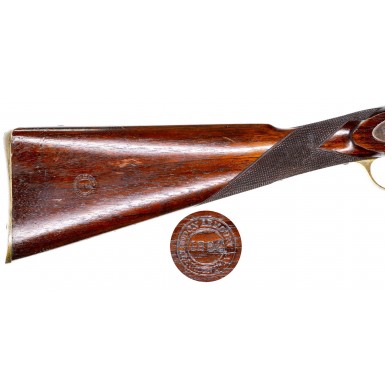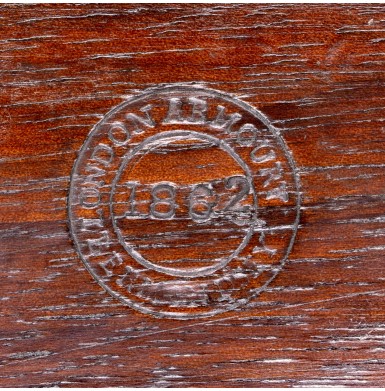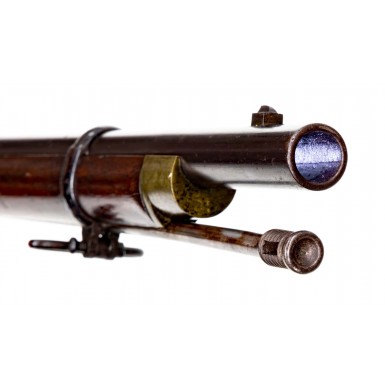Excellent London Armoury Company Pattern 1853 Enfield Rifle Musket
- Product Code: FLA-3763-SOLD
- Availability: Out Of Stock
-
$4,500.00
The London Armoury Company was established in 1856 with the sole intention to produce military pattern arms for the British War Department, as well as for the various export markets. The board of directors and shareholders of the company read like a “Who’s Who” of the 19th century English gun trade, and included (among others) Archibald Hamilton, Robert Adams, Richard Aston, James Kerr, John Deane and William Harding. London Armoury Company (L.A.C.) produced arms have the distinction of the being the only machine-made, fully interchangeable parts Enfields to be produced commercially in Great Britain during the Civil War era. The only other English manufacturer to produce interchangeable parts Enfields was the Royal Small Arms Factory (RSAF) at Enfield Lock, England’s “National Armory”. London Armoury Company’s interchangeable parts guns are instantly recognizable from other commercially made Enfields of the period by the use of round-eared brass lock escutcheons, instead of the normally encountered square wings, the use of Baddeley Patent barrel bands in the lower and middle positions (as of 1862), the use of wood screws with domed heads, instead of heads filed down to the contours of the gun stock furniture and the use of an oval sling swivel on the triggerguard rather than the trapezoidal one encountered on non-interchangeable parts guns. The Baddeley Patent barrel bands were an improvement over the standard Palmer clamping bands used on the typical Type III Pattern 1853 Enfield, and used a smaller, recessed tension screw and a more rounded profile of the band, to reduce the chances of the bands and screws catching on uniforms and equipment. These improved bands were adopted by the British military for the Type IV Pattern 1853 Enfield and became standard circa 1862. Only those arms produced at the London Armoury Company and at the Royal Small Arms Factory (RSAF) at Enfield Lock were manufactured with Baddeley bands during the American Civil War years.
The high quality, interchangeable part guns from L.A.C. were very desirable acquisitions for both US and CS purchasers during the American Civil War. As a result, both sides attempted to arrange to the purchase of as many of these first-class muskets as possible. However, the British government also preferred the London Armoury manufactured guns to those produced by the any of the other London and Birmingham contractors, and considered only the L.A.C. arms to be of the same quality as those manufactured at the R.S.A.F. As a result, the majority of Pattern 1853s produced by the London Armoury Company through mid-1862, when their initial British government contract expired, were delivered to the British War Department. Southern purchasing agent Caleb Huse certainly felt he had an inside track with the London Armoury Company, as the managing director was none other than Archibald Hamilton who was also the principle in the firm Sinclair, Hamilton & Company, a primary supplier of arms and equipment to the Confederacy. However, Huse’s post-war claim to have arranged for all London Armoury Company arms not contracted for by the British Government to be delivered to the Confederacy is not quite accurate. Huse noted “I succeeded in closing a contract under which I was to have all the arms the Company could manufacture, after filling a comparatively small order for the United States agent. This company during the remainder of the war turned all of its output of arms over to me for the Confederate army.” The small contract that Huse was referring to was one for 1,300 Pattern 1853s entered into by L.A.C. and the State of Massachusetts in mid-1861, to be delivered at the rate of 100 guns per week for 13 weeks. Hamilton, however, was apparently a businessman first and foremost and a supporter of the southern cause secondarily. Even after the expiration of the British and Massachusetts contracts, some arms were still being delivered to US buyers. This is indicated by the fact that to date, the purchase of less than 3,400 London Armoury Company Pattern 1853s can be documented by the Confederate invoices and receipts found in the McRae Papers. This number, when combined with the Massachusetts contract, essentially accounts for all the London Armoury Company’s excess production arms, other than those delivered on the British military contract from mid-1861 to mid-1862. At that point, all the London Armoury production capacity of some 1,300 guns per month (or some 33,800 guns from July 1, 1862-December 31, 1862) was theoretically available for Confederate purchase. However, extant examples and period documents do not indicate anywhere near that number of L.A.C. made guns were delivered to southern buyers. Today, London Armoury produced Pattern 1853 Enfields of any type are very difficult to find, and those with any Civil War provenance or markings are particularly difficult to located and extremely desirable. However, British military contract London Armoury Pattern 1853s are relatively rare as well, due to the limited production of the gun when compared to the total numbers of “Enfields” acquired by the British military during the 1860s. Early contract date guns, made in 1861 are particularly hard to find in good condition, as the London Armoury guns were designated as “First Class” arms for use by the regular army. This means that L.A.C. guns tended to be issued and used by the British Army around the world and often saw hard use in harsh conditions.
This London Armoury P1853 Enfield Rifle Musket is a scarce and exceptional condition example of one the commercial guns that may not have been produced for the British military, with a strong likelihood of having been sold to either Confederate or United States purchasing agents. The gun is an interesting example of some of marking anomalies that sometimes appear on London Armoury made guns. In this case the anomaly revolves around the proof marks. The gun has a partial set of British military proofs on the barrel with additional proof marks on the barrel having been obscured by stamping L.A.C. over them. In fact, the barrel is marked L.A.C. three times, which is a typical of any British military acquired London Armoury Enfield. A small number of examples of L.A.C. made guns with Confederate provenance, including Confederate inventory numbered examples exist that do not have London commercial proof marks, but are rather stamped L.A.C. three or four times. As failing to have a barrel proved at the proof house by a London maker was one of the most serious crimes of the period, it would be an exceptional situation in which any gunmaker would have risked their entire livelihood to evade the Draconian English proof laws. It is my belief that L.A.C. guns so marked were being rushed out the door for delivery to their Confederate buyers and for whatever reason the management was willing to risk their entire business by failing to have the guns proved. Similarly, it is my belief that this gun was assembled with a barrel previously inspected, proved and marked for British military service. However, the need to get the gun “out the door”, possibly as part of the Massachusetts contract resulted in the with the military markings being partially obscured by being over stamped with the L.A.C. mark. Interestingly no other British military marks are present on the gun, and the stock cartouche is a standard London Armoury Company commercial cartouche and not a British War Department storekeeper’s mark. To make the gun more interesting and even more uncommon in such wonderful condition is that it is an 1861 dated example.
As noted, other than the defaced British military proof marks, there are no British military marks on the gun and it and remains in an exceptionally high state of preservation for a Civil War period commercial Pattern 1853. The gun is in about EXCELLENT condition, remains extremely crisp and is absolutely gorgeous. The gun is clearly engraved in two lines on the lock, forward of the hammer: 1861 / L.A. Co. and with the usual {British Crown} / VR to the rear of the hammer. While the “VR” marking for Victoria Regina (Queen Victoria) under the crown does not typically appear on commercially made Enfields that were not destined for British military service, the letters appear on the locks of all London Armoury produced Enfield, whether British military contract guns or commercial guns. The lock is plain, without boarder line engraving and has a plain hammer, without “feathers”, typical of London produced guns. The lock retains about 40%-50% of its vivid color casehardening, primarily near the center and around the hammer, with the color having flaked and faded towards the perimeter of the lock leaving those areas more of a mottled and lightly oxidized tobacco brown color with some blue and purple mottling. The interior of the lock retains more of its original vivid case coloring. The interior of the lock is marked L.A.C over the mainspring and on the tumbler, bridle, and sear, as well as on the inside neck of the hammer. The lock is mechanically excellent and is extremely crisp, functioning perfectly on all positions. As described above, the breech of the gun is marked with a partial set of British military proof marks with additional proof marks above and below this mark having been over-stamped with L.A.C. marks, which are found three times on the breech. The barrel retains about 93%+ of its original rust blued finish which has faded and thinned slightly and is starting to blend with a smooth plum brown patina in the regions of thinning. There is some finish loss at the high edges and contact points of the barrel, where some silvering is present, with the worn finish revealing some of the base metal with a dull pewter patina. This is most noticeable around the muzzle and at a small number of minor dings and scuffs on the barrel. The barrel does show some lightly scattered freckled oxidation shot through the blue. The metal is entirely smooth with no pitting present, but some tiny flecks of minute pinpricking is present here and there, mostly around the breech, bolster and muzzle area. The bottom of the barrel retains about 95%+ of its original bright, rust-blued finish as well. The bottom of the barrel is unmarked marked other than the rear of the breech and rear of the breech plug, which are marked with the matching mating number 191Y. The gun has a NEAR EXCELLENT bore, which is mostly mirror bright and retains very crisp rifling with only some very minor frosting in the grooves and some very minor pinpricking scattered along its length. The gun retains its original long-range rear sight, and the leaf is marked with the Z/{CROWN}/4 stamp of the L.A.C. government sub-inspector. The gun retains its original upper sling swivel, mounted on the upper barrel band as well as its correct, original L.A.C. marked London Armoury Company lower swivel. The L.A.C. and R.S.A.F. swivels were rounded oval loops, while the swivels used by all other London and Birmingham contractors had a more trapezoidal appearance. The gun retains the correct barrel band configuration as well for a gun produced before the mid-1862 changeover to the Baddeley bands in the middle and lower positions. All three bands are the correct, earlier pattern Palmer clamping bands and all three retain their original washers at the end of the screw to prevent it from being completely removed from the band and being lost. The bands retain about 20%-40% of their original blued finish, with the loss being from wear on the high edges, revealing a dull pewter patina under the blue. An original, correct ramrod is in the channel under the stock, and appears to be original to the gun. It is full-length and retains its original threads at the end. The gun also retains an original, period “Snap Cap”, or nipple protector. It is suspended from the triggerguard on an iron split ring with a correct teardrop shaped brass chain. The metal base of the protector is intact, but nearly all of the leather pad is missing. The brass furniture has an attractive, medium mustard patina. The gun also retains all the correct, original domed head mounting screws. The screws retain relatively crisp slots and the at least some of their original blued finish. The stock of the gun is in about EXCELLENT condition as well. It is full-length and solid, with no breaks or repairs noted. As would be expected from a London Armoury produced musket, the wood to metal fit is excellent throughout. The standard London Armoury commercial production cartouche is present on the obverse stock, reading LONDON ARMOURY BERMONDSEY in a roundel around the date 1862. The 1861 dated lock and 1862 dated stock suggest assembly in early 1862 with a left over lock from the previous year, not unlike US military arms of the period with lock and barrel dates mismatched by one year. The stock is of the checkered variety more associated with commercial “Volunteer Rifles”, not British military contract guns. Some examples of checkered London Armoury Pattern 1853 were acquired by both the North and the South as well, with Fuller & Steuart giving these checkered guns the nickname of “Jeff Davis Rifles” in their seminal book Firearms of the Confederacy. The checkering at the wrist and on the forend remains extremely crisp and is very well cut, showing only the most minimal wear. The stock is extremely crisp and sharp throughout with outstanding edges and lines. The stock shows the usual scattered minor bumps, dings, scuffs and the light handling marks that one would expect to find on a 150-years military long arm. Amazingly for its age, the stock shows no signs of abuse.
Overall, this is a really outstanding condition, 100% complete and correct example of a scarce London Armoury Company produced Pattern 1853 Enfield Rifle Musket that was manufactured in early 1862. This is a scarce and eminently desirable gun to add to any advanced collection of British long arms, or Patten 1853 Enfields, in particular. The gun is in absolutely wonderful condition and is extremely attractive, with the photos not really doing the condition of the gun justice. This gun is of sufficient quality to please the most discriminating collector and belongs in an advanced military arms collection, and with its lack of the expected British military marks as well as the strangely added L.A.C. marks, it is a legitimate candidate to have been imported for use during the American Civil War.
SOLD
Tags: Excellent, London, Armoury, Company, Pattern, 1853, Enfield, Rifle, Musket

